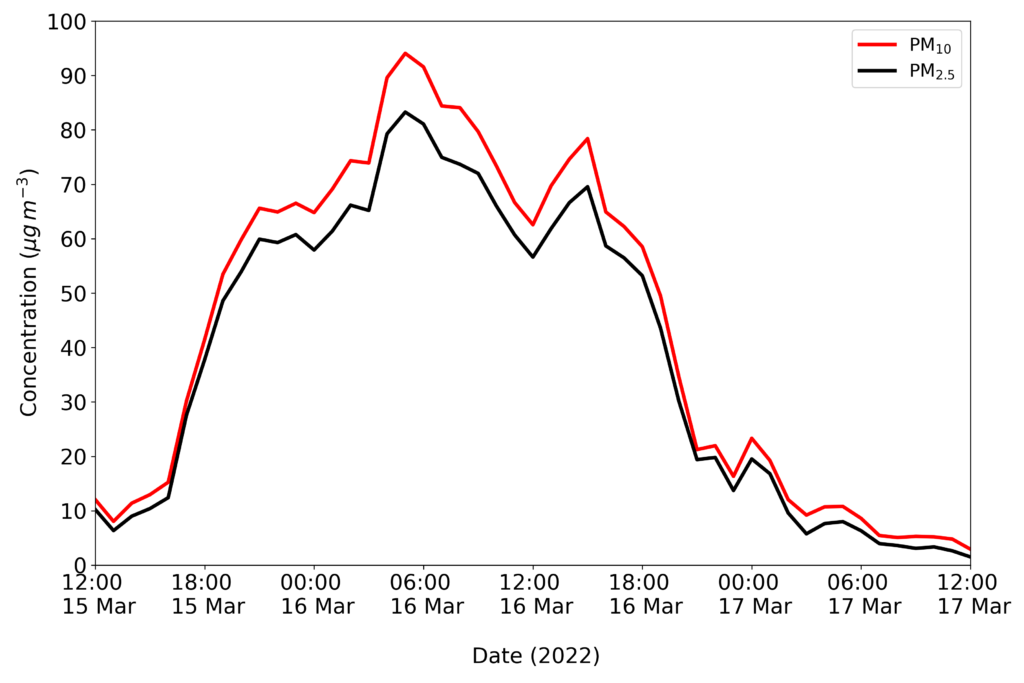Saharan dust: the possible issues with particles long-range transport
Last Thursday, most people living in southern England, like myself, witnessed orange skies and, later, found sand deposited on their windows, cars or front door. As an atmospheric scientist, a few weeks before it, I installed a low-cost sensor (see Tech specs section below) for air quality monitoring just outside my window to gather an indicative measurement of the levels of pollutants in the neighbourhood where I live. The device provides measurements of temperature, relative humidity and pressure, and indicative levels of PM2.5, PM10. Roughly speaking, PM2.5, PM10 refer to the concentration in the form of mass of all the particles with a diameter smaller than 2.5 and 10 micrometres, respectively. A more accurate definition of PM mass concentrations is provided by the European Union Council [1]. Still, the approximate description is sufficient for the discussion that follows.
Fascinated by the amount of dust being transported from the Sahara desert, I wanted to check whether my sensor was able to provide data indicating that the event took place. In particular, I was curious to see how the presence of sand affected, if at all, the PM levels. Therefore, I downloaded the PM concentration data from my sensor and produced the plot shown in Figure 1.

Figure 1 exhibits a range of stimulating features. Firstly, PM2.5 and PM10 concentrations have increased by up to a factor of 9 compared to before (15th March) and after (17th March) the event. Secondly, it is evident how the discrepancy between PM2.5 and PM10 concentrations increases during the 16th March. This behaviour can be explained considering the wide range of Saharan dust particles dimensions, from 0.1 to 50 micrometres. Consequently, if a higher fraction of particles greater than 2.5 micrometres is present, the concentration of PM10 starts to deviate significantly from PM2.5, as observed in Figure 1. Thirdly, the slight decrease in PM concentration around midday on 16th March was caused by rain. This phenomenon is an aerosol removal mechanism called washout [2]. In simple words, the droplets capture particles and deposit them on the ground when it rains. That is why you may have found traces of sand on your window or your wheelie bin.
This fascinating event served as a perfect example to analyse and explain some of the most common aerosol phenomena in the atmosphere. But that is not the end of the story. We observed and witnessed how large concentrations of Saharan dust can be transported for long distances with the right combination of convection and winds. While inhaling sand is not particularly harmful, it could still irritate a person’s airways and cause respiratory issues, especially to allergic and susceptible individuals. The long transport of Saharan dust highlights the threat to human health when more toxic particles emitted in the atmosphere can spread across the globe. In this light, a definition of PM as mass concentration without chemical speciation results insufficient. The risk of jeopardising reduced policy emissions by single nations without them being shared globally (see COP26) becomes more real.
References
[1] The European Parliament and of the council of the European Union. Directive 2008/50/EC of the European Parliament and of the council of 21 May 2008 on ambient air quality and cleaner air for Europe. Official Journal of the European Union 2008, 51, 1–44.
[2] Kajino, Mizuo, and Masahide Aikawa. “A model validation study of the washout/rainout contribution of sulfate and nitrate in wet deposition compared with precipitation chemistry data in Japan.” Atmospheric Environment 117 (2015): 124-134.
Tech specs
The sensor used to measure PM levels is a PMS5003;
The sensor used to measure temperature, relative humidity and pressure is a BME280 mounted on the Enviro for Raspberry Pi;
Both sensors are connected to a Raspberry Pi Zero. The data are sent to the Luftdaten website and are open access; To download the data relative to my sensors and the code to generate the plot shown above, visit my dedicated GitHub repo.